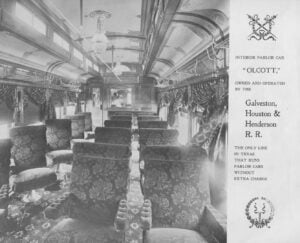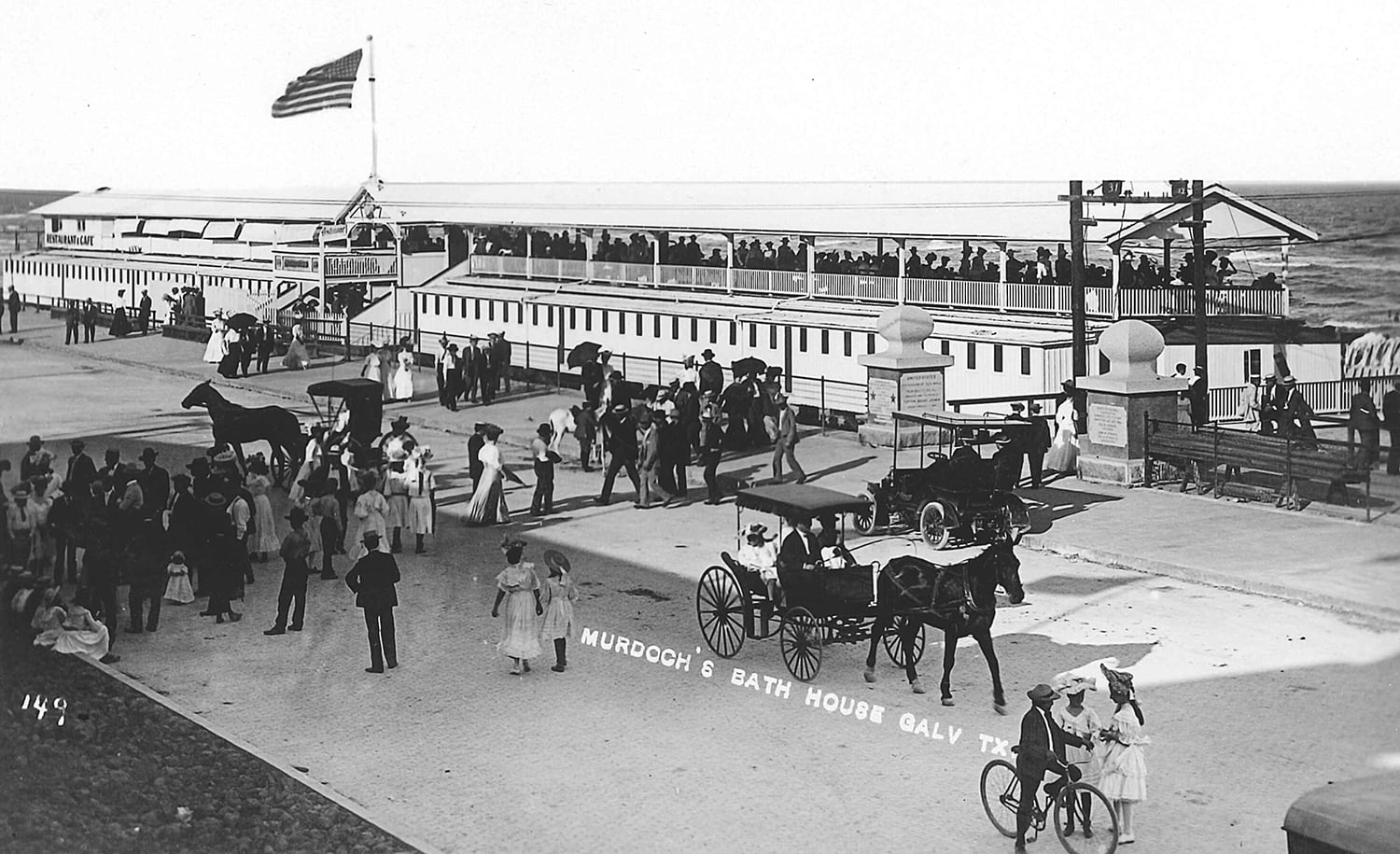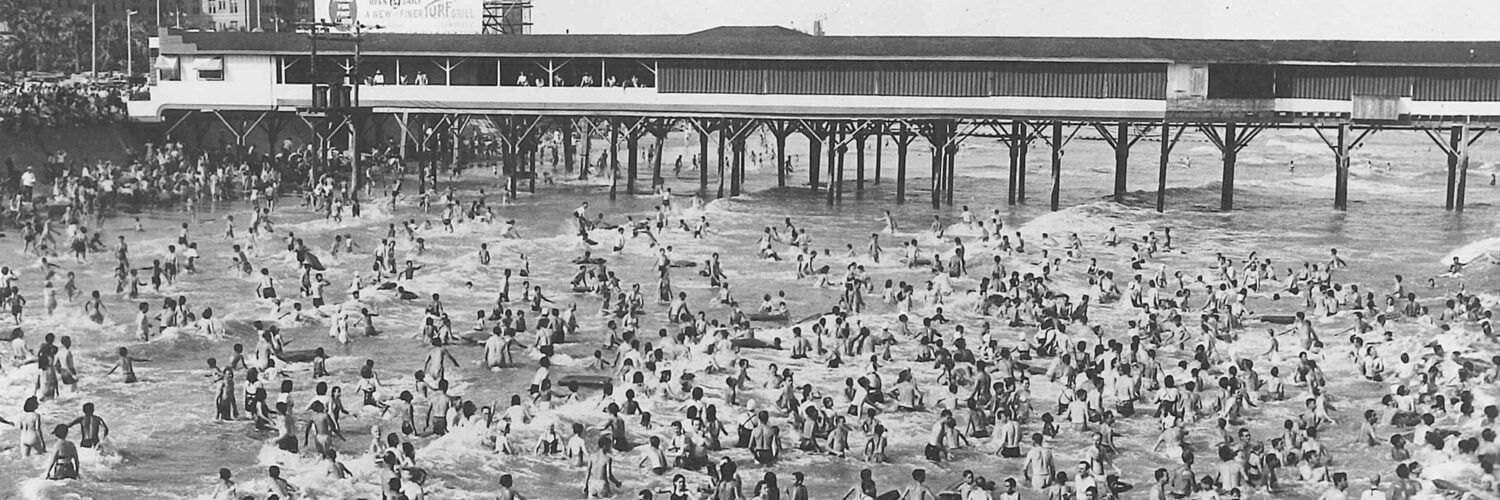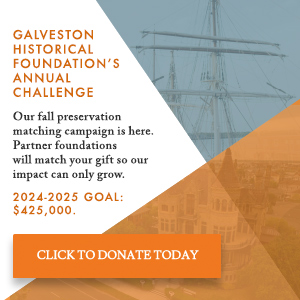DAY TRIPPER: 150 YEARS OF GETTING TO AND AROUND GALVESTON
BY ELISABETH CARROLL PARKS, #GALVESTONHISTORY CONTRIBUTOR
Over the last two centuries in Galveston, as the world gained more leisure time and sought new ways to spend it, the beach’s inherent push and pull between thrill-seeking and relaxation produced a rich ecosystem of complementary attractions: seawall ferris wheels and dance floors with Gulf views, 19th-century skinny dipping and 20th-century motor courts, architectural marvels and maritime wonders, brightly lit casinos and quiet, wild marshes. Beginning in the mid-to-late 1800s, as Galveston began to promote itself more as a sophisticated vacation destination than a bustling center of commerce, a new nickname emerged for the prestigious port city: The Playground of the Southwest.Getting to Galveston––and then getting around once you’re here––has always been an integral part of the city’s story.

Galveston Island is separated from the U.S. mainland by Galveston Bay, a 17-mile wide, 30-mile long expanse of salt water. On the far side of the island, of course, is the Gulf of Mexico. For hundreds of years, great ships have docked in Galveston’s port, bringing people and cultures that would shape not just the island, but the entire country.
To reach the island from the Texas mainland during Galveston’s reign as a 19th century economic hub and tourist destination, most travelers depended on trains. “We’re at the end of the line or the beginning of the line, however you want to look at it,” says Jami Durham, Property Research & Cultural History Historian for the Galveston Historical Foundation. “People would get on the train as far away as Chicago and ride all the way to the Gulf of Mexico.”
A railroad bridge crossing Galveston Bay was finished in 1860, and the Galveston Houston & Henderson Railroad (GH&H) company began service to the island. GH&H offered luxury parlor cars, transforming the travel experience and making a trip to Galveston all the more enticing.

On the island, horse-drawn carriages shuttled guests to and fro. Bicycles provided an easy way to explore city streets and sandy beaches alike. In 1906––six years after the cataclysmic storm––the first portion of the Galveston seawall was completed. Seawall Boulevard became a thoroughfare trafficked by all modes of transportation, all at once.

Then, another set of wheels changed everything.
“There were automobiles in the 19th century and early 20th century, but they were very large and cumbersome, and only very wealthy people had them,” says Dwyane Jones, Executive Director/Chief Executive Officer for the Galveston Historical Foundation. “Then, in 1909 and 1910, the Model T began to become popular. It was a more affordable option produced by the Ford Motor Company, and more and more people began buying them.”
EXCLUSIVE MEMBER-ONLY CONTENT
 GalvestonHistory+ members have access to exclusive video content associated with this online feature. Log into your member account here, or join today for access to our monthly content, member-only ticketing, and more.
GalvestonHistory+ members have access to exclusive video content associated with this online feature. Log into your member account here, or join today for access to our monthly content, member-only ticketing, and more.
As the Model T began to change American life, construction of an automobile causeway connecting Galveston to the mainland began in 1911 and ended the following year. While trains remained the most popular route to the island until about 1920, a growing number of travelers fell in love with the flexibility and independence of the automobile. “The railroad had fixed lines and fixed travel schedules, but with an automobile, you could take off and see the Grand Canyon or whatever you wanted,” Jones says. “Tourists who had cars were interested in seeing things they couldn’t see on the railroad.”

As roads filled with cars, businesses such as tourist courts, roadside restaurants, and car washes appeared to complement automobile travel. Early automobile enthusiasts also often carried camping equipment with them, and stopped to camp on the side of the road. Eventually, parks became a popular place to camp, which then helped spur the creation of auto parks––designated spaces designed to accommodate camping automobile tourists with parking and a campsite, plus amenities including restaurants, grocery stores, showers, gas stations, and more.

Campgrounds soon gave way to motor courts with small, individual dwellings automobile tourists could rent. “The whole form and industry of lodging began to develop and become more sophisticated,” Jones says. “Until the automobile, the only places you could stay other than campgrounds would be in a railroad hotel downtown somewhere. Often, they weren’t very nice, and they weren’t always easy to get in and out of.” Motor courts changed that.

In Galveston, Hawkins Tourist Camp began as beachside accommodations for automobile campers. Soon, the business began building permanent, small cottages, nestled next to designated parking spaces. In 1928, the Moody family commissioned the construction of Miramar Courts, a structure featuring small individual rooms along the seawall, as well as gas stations and restaurants. “The spaces evolved over time, from just a room with a bed and maybe a chair, to a room with a chair and a bed and a shower, and then maybe a kitchenette,” Jones explains.
Chevrolet, General Motors, and Ford took over the automobile market in the 1950s. As Thunderbirds and Bel Airs multiplied, a new route to Galveston also opened: the Gulf Freeway. Started in 1946 and completed in 1952, the Gulf Freeway cut the travel time from Houston to Galveston in half––and ensured year-round travel to the island.
Today, all that’s old is new again. Tourists and residents alike cherish Galveston’s walkability and bike-friendly layout. And as for automobiles? Millions jump in their cars to drive to Galveston every single year. “The automobile was clearly the thing that impacted the growth of tourism,” Jones says. “The advent of the car set off what would become exponential growth that continued throughout the 20th century.”








Thank you for this article. I have been visiting the island since the Gulf Freeway was finished. My Dad complained about the two lane highway from Dallas to Houston, too many cars to try to pass. (Hwy 77). Still adore Gaido’s and have fallen in love with our Elissa. My daughter and her family visit every year! There is ALWAYS something new to see or do! BTW, we enjoyed last spring’s Tall Ship Challenge!!!